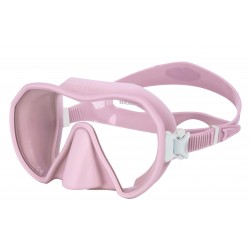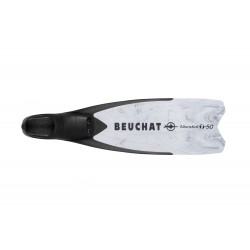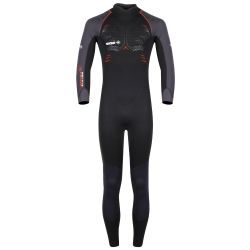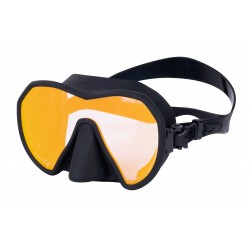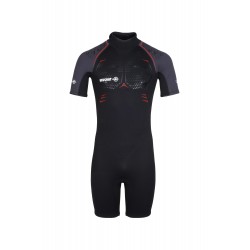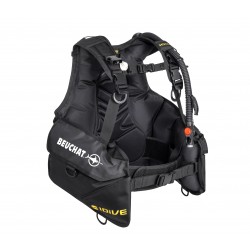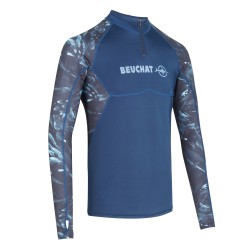How to start spearfishing?
Would you like to start spearfishing and avoid the pitfalls? Then you are reading the right article.
To begin with, before you get out to conquer the underwater world, you will need to identify the authorised spearfishing areas. You cannot point your speargun at just anything, and make sure that it is never loaded out of the water or near swimmers. Read your speargun’s instructions carefully before using it.
It is strongly recommended to be accompanied by an experienced spearfisher. Some marine species are also protected, so it is necessary to find out which ones are and what their mesh sizes are (mesh sizes are the minimum sizes of fish below which they should not be taken).
Planning my spear session
Set aside half a day and make sure you eat well and hydrate as much as possible before your session. Spearfishing is a sport that requires a lot of energy, you will need to build up your strength!
The spearficher's kit
A wetsuit
You will probably be in the water for several hours, and without a wetsuit you will quickly get cold. There are several layers of wetsuits depending on your spear area:
You must choose your wetsuit according to your spear area and the season:
- Warm water (+25°) a maximum of 3.5 mm
- Temperate water (15°-25°) 5mm
- Cold water (7-15°) a 7mm
- Ice water (0°-7°) a minimum of 8mm
Choosing your wetsuit: it is important to try on your first wetsuit to see if it is the right fit and size for you. A wetsuit fits well if there are no air pockets or creases. Choose a wetsuit with an internal slit to ensure that it is closer to your skin and prevents water from circulating. When you put it on, it is recommended that you moisten yourself to slide inside. Remember that you must feel comfortable!
Be careful: your fingernails can damage the neoprene and leave marks on the suit, so be careful when putting it on.
Gloves
Essential equipment, gloves protect your hands when handling the speargun and its metal parts, but also rocks, sea urchins and other species that you may encounter. They also insulate you from the cold, as the extremities are the parts of the body that get cold the fastest.
How do you choose a pair of gloves?
Their thickness, find the one that suits you according to the temperature of the water (see paragraph above): from 0.5mm to 7mm
Their resistance to abrasion: they will be subjected to rocks, sharp objects and marine species likely to injure you. The thicker the glove, the more resistant it is.
Putting on: very thick gloves (5-7mm) are usually pre-shaped to make them easier to put on. The thinner ones (0.5-3mm), being more flexible, are very easy to put on. Keep in mind that a glove is a second skin, just like your suit.
Fins
All fins are made up of shoes and blades. To begin with, we recommend that you do not choose fins that are too rigid, so that they are as versatile as possible and to reduce the risk of cramping. As for the size, you will have to take a size larger than yours because you have to take into account the neoprene liner. There are more or less rigid booties but the only valid advice we can give you is to take a bootie in which you feel comfortable, there should be no pressure points or rubbing, comfort comes first. When you try on your fin, you should be able to pull on the blade without the fin coming off, if not, the fin is either too big or not the right shape for you.
The mask
A good spearfishing mask is generally small in size to facilitate compensation during immersion. It is important to have a large field of vision so as not to miss any fish. The mask is a personal choice as it must be adapted to your face shape. To find it, put it on your face without passing the strap behind your head. Then breathe in through your nose: if the mask is your size, it should hold itself like a suction cup and only come off when you breathe out.
The snorkel
To complete the mask, we now need to choose a snorkel, of which there are two types: simple and with a valve.
We recommend the simple one. There are flexible or more rigid ones, it's up to you to see what suits you. A snorkel should be of a good diameter, not too long so that it fits the shape of your face.
The speargun
The part you probably expect the most, the choice of the speargun (or crossbow).
Depending on the type of spearfishing, some are more suitable than others:
- short ones (60cm or less) are more suitable for hole fishing
- medium (75-90cm) are suitable for all types of spearfishing
- the long ones (100 cm and more) are more adapted to agachon and Indian spearfishing
To begin with, a medium speargun is an ideal compromise, you can try several types of spearfishing as you progress.
Regarding the method used, we advise you to start with the Indian(see our article on the different spearfishing techniques).
Choosing a speargun to start with :
- A comfortable grip -> so that you feel comfortable in your hand
- A suitable angle -> so that your wrist is well positioned
- A closed head -> to facilitate the reloading of the arrow
The ideal is to hold it in your hand to make your own opinion, always unloaded out of the water. To start with, a closed head speargun is easier to use, the reloading system is easier than an open head. Read the instructions of your speargun carefully before using it.
Leadbelt
To practice spearfishing and to be able to descend by apnea without too much effort, you will have to equip yourself with a lead belt (or ballast). Its purpose is not to make you descend but to reduce your efforts to do so, you should not force yourself to come up. Remember that it is better not to have enough lead than too much. It is up to you to test and determine the number of kilos of lead you need. As for the belt, choose a plastic or nylon American buckle, it must be easy to detach so that you can release the belt in case of emergency.
Where to hang my fish?
Once your fish has been caught, you will have to hang it up. You have two options for hanging up your fish:
- Your buoy
- Your belt
If you choose your belt, remember to ensure that the fish does not interfere with the opening of the belt.
The buoy
What is the purpose of the buoy?
When spearfishing, for your safety, it is essential to signal your presence at sea:
- the buoy
- the spearfishing board
There are two types of inflatable buoys used to signal a zone
- round buoys: small size
- long buoys: ideal for hanging up equipment
There is also the spearfishing board, used by experienced spearfishers, which allows them to put more equipment and for some to rest on it.
The knife
Another essential accessory: the knife. Ideally, it should have a thin, long blade to open its grip and clean it properly. For beginners, a classic spearfishing knife will suffice. It should be stored in a place where it will not snag, such as along the calf.
Safety
Now that you are equipped, there are a few important points to know to ensure your safety:
- Always go out in pairs
- Remember to follow each other (don't go off on your own) and to look after each other
- Do not forget your buoy to signal your presence
- Always wear gloves
- Watch out for bathers in your area (you can start from a beach)
- Don’t make too many descents in a row, take regular breaks, freediving requires a lot of energy and without training you can quickly become exhausted, a beginner lasts on average 30s in apnea
- Do not try to dive too deep, you need time to adapt
- The speargun must be unloaded when you are out of the water
- Before shooting, make sure you have removed the safety from your speargun, you are not too close to the rocks and above all that you are allowed to take the species that is at the end of the arrow
- Once the fish has been taken, cut off the tail fin, this is a legal requirement and proves that it is not intended for sale.
- For an optimal exit from the water, we advise you to wear sandals! No no, this is not a joke, they will protect your slippers if you have to walk on rocks to get into the water, avoid sea urchins... you can hang them on your buoy.
After the spear session
After the spear session, it is important to clean your equipment with fresh water, let it dry in the open air, if possible out of the sun.
Spearfisher advice
Don't give up if you don't manage to bring in any fish on your first outing, spearfishing is a difficult activity that requires patience, technique and calm. Enjoy the moment, relax, observe and respect the environment in which you are. Be persistent and you will soon be enjoying your first fish. #ToEnjoyAndProtectTheSea
| Wetsuit |
Men : ESPADON Women : ATHENA |
| Fins | MUNDIAL ONE-50 |
| Mask | SHARK |
| Snorkel | SPY |
| Speargun | |
| Buoy | |
| Knife | |
| Belt |


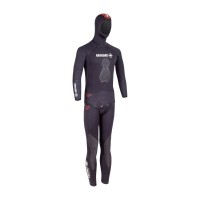
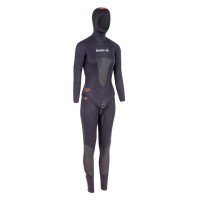
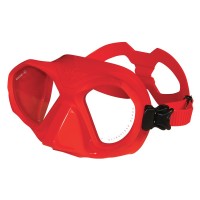
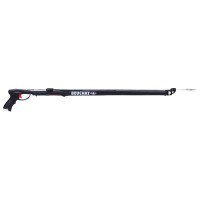
 Snorkeling
Snorkeling
 Beuchat Team
Beuchat Team
 Scuba diving
Scuba diving
 Free Diving
Free Diving
 Snorkeling
Snorkeling
 Beuchat Team Spearfishing
Beuchat Team Spearfishing
